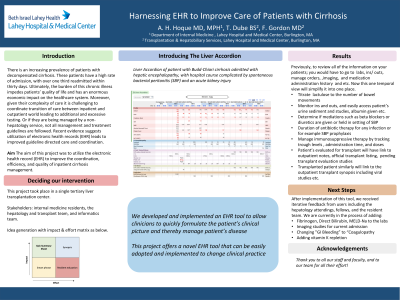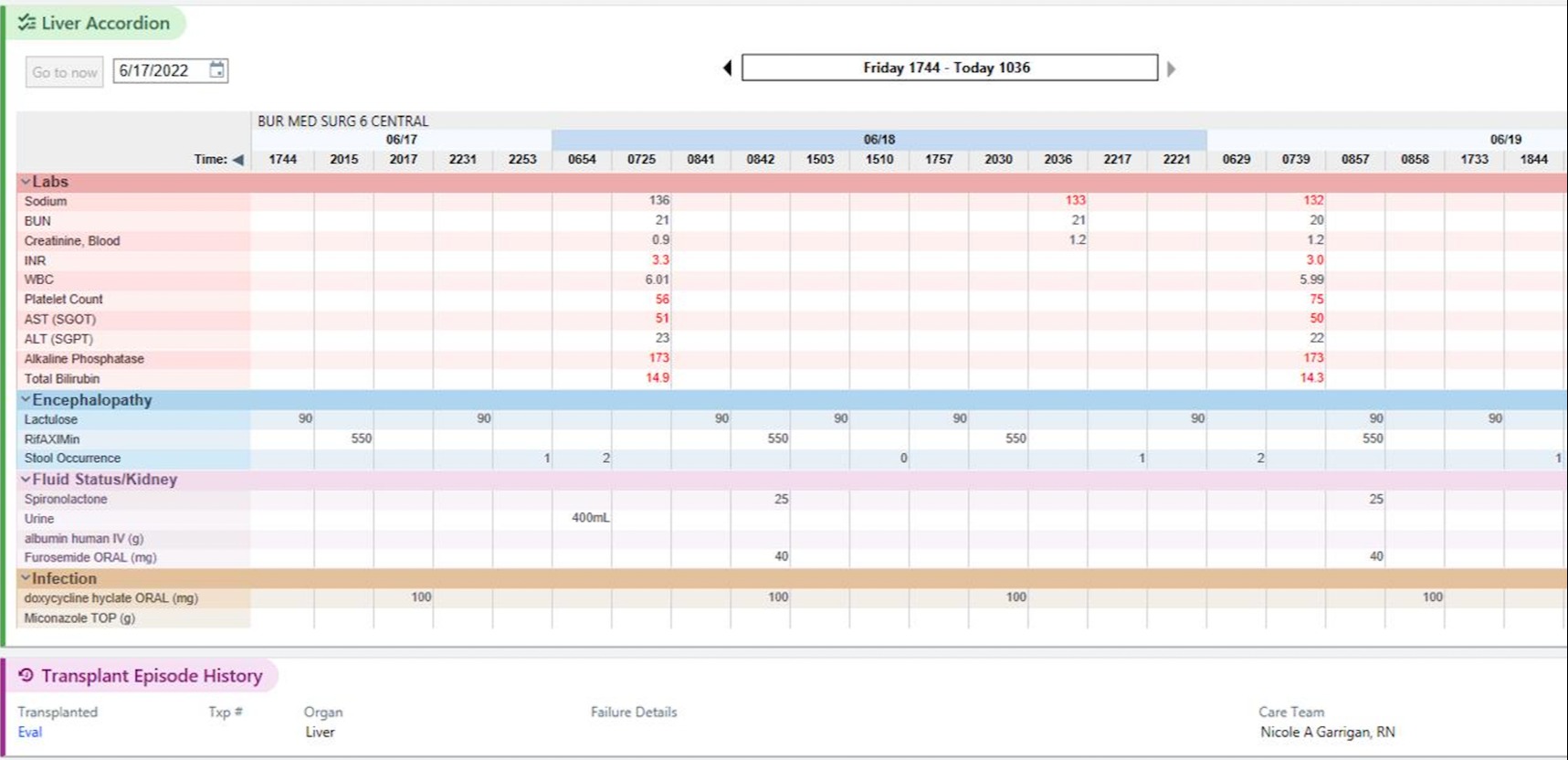Back


Poster Session D - Tuesday Morning
Category: Liver
D0498 - Harnessing EHR to Improve Care of Patients With Cirrhosis
Tuesday, October 25, 2022
10:00 AM – 12:00 PM ET
Location: Crown Ballroom

Has Audio

Asahi Hoque, MD, MPH
Lahey Hospital & Medical Center
Burlington, MA
Presenting Author(s)
Asahi Hoque, MD, MPH, Tony Dube, BS, Fredric Gordon, MD
Lahey Hospital & Medical Center, Burlington, MA
Introduction: There is an increasing prevalence of patients with decompensated cirrhosis. These patients have a high rate of admission, with over one third readmitted within thirty days. Ultimately, the burden of this chronic illness impedes patients’ quality of life and has an enormous economic impact on the healthcare system. Due to their complex care it is challenging to transition care from inpatient to outpatient management, and if they are being managed by a non-hepatology service, it is likely that not all treatment guidelines are followed. Recent evidence suggests utilization of electronic health records (EHR) leads to improved guideline directed care and coordination. The aim of this project was to utilize the electronic health record (EHR) to improve the coordination, efficiency, and quality of inpatient cirrhosis management.
Methods: This project took place in a single tertiary liver transplant center. A group of stakeholders was formed from internal medicine residents, the hepatology and transplant team, and informatics team. Based on patients being managed, ideas were generated that were subsequently plotted on an impact effort matrix. This helped the team determine direction of EHR intervention.
Results: The “Liver Accordion” (Figure 1) was designed to eliminate steps of the workflow and compile necessary temporal information related to patients with cirrhosis or those transplanted for cirrhosis in one view. For example, a patient with a history of decompensated cirrhosis with history of hepatic encephalopathy and an acute kidney injury. The flow sheet would compile the number of recorded bowel movements and the amount of lactulose ordered and received, amount of albumin given, and if their beta blocker and diuretics were held. It also aims to coordinate inpatient care cognizant of their overall care by pulling information regarding patient’s last hepatology appointment, endoscopy screening, or hepatocellular carcinoma screening in a separate tab linked below.
Discussion: The objective of our solution was to develop and implement a temporal data view in the institution’s EHR to allow clinicians to quickly formulate a clinical picture of the patient and thereby track and manage patient’s disease. This will improve care coordination and workflow. Moreover, if adopted by hospitalist teams not trained in managing cirrhosis, patients will not miss recommended treatment. This project offers a novel EHR tool that can be easily adopted and implemented to change clinical practice.

Disclosures:
Asahi Hoque, MD, MPH, Tony Dube, BS, Fredric Gordon, MD. D0498 - Harnessing EHR to Improve Care of Patients With Cirrhosis, ACG 2022 Annual Scientific Meeting Abstracts. Charlotte, NC: American College of Gastroenterology.
Lahey Hospital & Medical Center, Burlington, MA
Introduction: There is an increasing prevalence of patients with decompensated cirrhosis. These patients have a high rate of admission, with over one third readmitted within thirty days. Ultimately, the burden of this chronic illness impedes patients’ quality of life and has an enormous economic impact on the healthcare system. Due to their complex care it is challenging to transition care from inpatient to outpatient management, and if they are being managed by a non-hepatology service, it is likely that not all treatment guidelines are followed. Recent evidence suggests utilization of electronic health records (EHR) leads to improved guideline directed care and coordination. The aim of this project was to utilize the electronic health record (EHR) to improve the coordination, efficiency, and quality of inpatient cirrhosis management.
Methods: This project took place in a single tertiary liver transplant center. A group of stakeholders was formed from internal medicine residents, the hepatology and transplant team, and informatics team. Based on patients being managed, ideas were generated that were subsequently plotted on an impact effort matrix. This helped the team determine direction of EHR intervention.
Results: The “Liver Accordion” (Figure 1) was designed to eliminate steps of the workflow and compile necessary temporal information related to patients with cirrhosis or those transplanted for cirrhosis in one view. For example, a patient with a history of decompensated cirrhosis with history of hepatic encephalopathy and an acute kidney injury. The flow sheet would compile the number of recorded bowel movements and the amount of lactulose ordered and received, amount of albumin given, and if their beta blocker and diuretics were held. It also aims to coordinate inpatient care cognizant of their overall care by pulling information regarding patient’s last hepatology appointment, endoscopy screening, or hepatocellular carcinoma screening in a separate tab linked below.
Discussion: The objective of our solution was to develop and implement a temporal data view in the institution’s EHR to allow clinicians to quickly formulate a clinical picture of the patient and thereby track and manage patient’s disease. This will improve care coordination and workflow. Moreover, if adopted by hospitalist teams not trained in managing cirrhosis, patients will not miss recommended treatment. This project offers a novel EHR tool that can be easily adopted and implemented to change clinical practice.

Figure: Example of Liver Accordion in a patient being managed for hepatic encephalopathy
Disclosures:
Asahi Hoque indicated no relevant financial relationships.
Tony Dube indicated no relevant financial relationships.
Fredric Gordon: Moderna – DSMB.
Asahi Hoque, MD, MPH, Tony Dube, BS, Fredric Gordon, MD. D0498 - Harnessing EHR to Improve Care of Patients With Cirrhosis, ACG 2022 Annual Scientific Meeting Abstracts. Charlotte, NC: American College of Gastroenterology.
